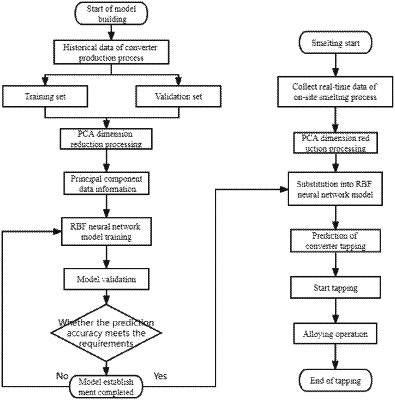| CPC C21C 5/30 (2013.01) [G06N 5/00 (2013.01); C21C 2300/06 (2013.01)] | 6 Claims |

|
1. A method for determining tapping amount of a converter, comprising following steps:
S1, collecting a converter production data set and establishing a prediction model database; the converter production data set includes: blowing cycle, oxygen supply time, total oxygen content, whether to blow carbon or not;
S2, conducting data screening and elutriation on the collected converter production data set, and conducting normalization preprocessing on the screened and elutriated data;
S3, determining process parameter variables that affect tapping amount of the converter as input variables to a prediction model of RBF neural network for converter tapping capacity;
the step S3 comprises: determining the input variables by conducting a bivariate correlation analysis to examine a relationship between process parameter variables in step S1 and the tapping amount of the converter;
S4, performing dimensionality reduction processing on converter production process data using principal component analysis (PCA);
the principal component analysis comprises:
1) data standardization processing, and an obtained standardization matrix;
2) calculating a correlation coefficient matrix of the standardization matrix;
3) solving an eigenvalues and eigenvectors of the correlation coefficient matrix;
4) calculating a variance contribution rate and a cumulative variance contribution rate of the principal component variables;
5) selecting first m principal component variables with a cumulative variance contribution rate greater than 80% as the target variable after dimensionality reduction;
S5, establishing the prediction model of RBF neural network for converter tapping capacity;
S6, training and testing the prediction model;
S7, collecting real-time data of on-site smelting process;
S8, performing dimensionality reduction processing on the collected real-time data using the principal component analysis;
S9, applying the prediction model based on RBF neural network to predict the tapping amount of the converter;
S10, adding ferroalloy during the tapping process based on the tapping amount obtained by the prediction model; after the tapping process, storing the tapping amount in the prediction model database to update the prediction model based on the RBF neural network.
|